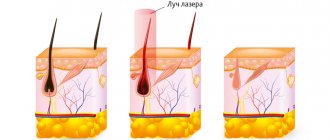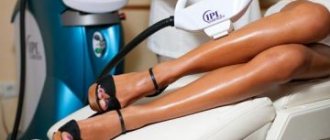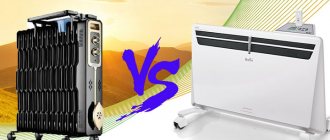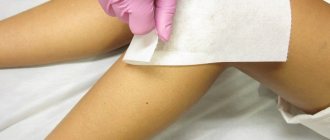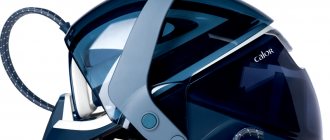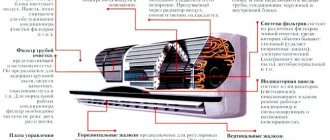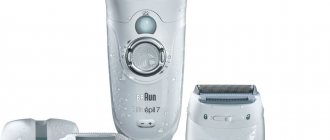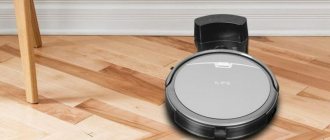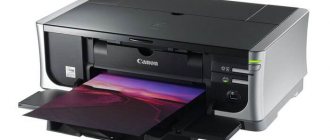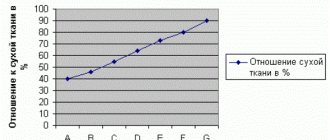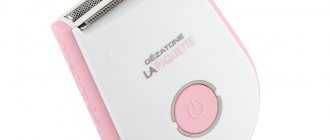Light hair removal is one of the most popular procedures in beauty salons because... only they are able to remove excess vegetation for a long period of time. Both procedures are painless, simple, effective and similar in nature: removal of unwanted hair using light radiation. In the article we will tell you which method is better to choose, how photoepilation differs from laser hair removal, their pros and cons.
The difference between laser hair removal and photoepilation
Photoepilation or laser hair removal have a similar basis, but there are still differences and differences between these manipulations:
- method of influence. Laser hair removal destroys the follicle taking into account the color type of skin and hair structure, and photoepilation is universal;
- duration of the procedure. Photoepilation takes less time because... capable of treating a large area of skin with one flash, unlike laser exposure;
- number of procedures. The laser method requires more sessions than photoepilation.
- photoepilation is less painful and ideal for people with sensitive skin;
- zone of the treated area - with laser hair removal, the area covered is limited, but with photoepilation, the flash spectrum is wide.
- cost of sessions - the price of photoepilation procedures is higher than for the laser method.
What is the difference between a laser epilator and a photoepilator?
To understand what is more suitable for you, laser or photo hair removal, you need to find out which epilator is better, photo or laser, and what are their differences. Disassemble:
- operating principle of the devices;
- strength of pain;
- efficiency;
- speed of the procedure, etc.
The principle of operation of a laser epilator
What is the difference between a laser epilator and a photoepilator? First of all, the principle of operation. The laser wave affects the melanin, which is located in the hair. This pigment is destroyed when heated. The main task is to destroy the hair follicle. For this to happen, it is important to set the wavelength correctly.
The laser beam acts in a narrow direction over a small area, so the manipulation lasts a long time.
After the session, many hairs remain in their place, only a few are burned out. The bulk will fall out after a certain period of time. It is different for everyone - 7-14 days. It will be possible to lose absolutely all vegetation only after 5-10 procedures.
Advantages
The advantages of laser hair removal include:
- lack of contact of the instrument with the epidermis;
- minimal number of complications;
- no damage to the skin;
- lack of blood;
- some types of lasers can remove even light hair;
- the result lasts for years;
- requires minimal recovery time.
Flaws
Among the disadvantages:
- slight soreness;
- high price;
- duration is longer than photoepilation;
- Sometimes burns are possible (if hair removal is done with an alexandrite laser).
The principle of operation of the photoepilator
A photoepilator, unlike a laser one, delivers several light waves at once. They have different lengths. They immediately capture a large area, but it is not a fact that every bulb will be burned out. For full results, you will need to visit the cosmetologist’s office 7-15 times. This is more than with laser hair removal.
If you have dark skin, then photoepilation will be inappropriate and dangerous. After the procedure, skin burns are guaranteed.
Advantages
Such a device is capable of:
- treat a large area in a minimum amount of time;
- minimum pain;
- the dermis looks young and beautiful after manipulation, taking into account that all requirements and nuances are taken into account;
- long lasting result;
- the epidermis is not damaged.
Flaws
Before you go to the salon and agree to photoepilation, you need to familiarize yourself with the disadvantages of the procedure. This:
- high cost (especially considering that you will have to repeat sessions many times);
- not very effective on light and gray vegetation;
- there is a risk of getting a burn (not only on dark skin, but also on light skin, if the specialist has configured the device incorrectly).
What is safer: photoepilation or laser hair removal?
Clients often ask the question about which hair removal is more effective: photo hair removal or laser hair removal. The difference between photoepilation and laser hair removal is approximately the same. The beam during laser hair removal acts on the skin of the face and body gently, as it affects only the bulb and does not affect nearby places on the skin. But still, modern photoepilators have a wide spectrum of radiation, which use various attachments and filters. They help protect the patient from the negative effects of harmful flashes, and their functions allow you to adjust the required length of light energy. After both procedures, the skin acquires slight redness and swelling, which indicates the correctness of the technique. The pain sensations of both procedures are at the same level. This is the difference between photoepilation and laser hair removal.
Laser hair removal
In this case, a laser beam with a wavelength of 755 nm is used to remove hair. This is the standard value, although there are also devices that emit light at a completely different wavelength (for example, 808 nm). The higher the wavelength of laser light, the better, because this suggests greater light absorption by hair melanin. “Point” work and correctly set wavelength allow you to act exclusively on the hair and not on the skin. This eliminates the possibility of heating the skin, but requires a lot of time, because you have to “process” each hair separately.
Operating principle
What is better and more effective: laser or photoepilation, we suggest comparing and identifying the differences between the two methods below:
Laser hair removal involves heating the hair follicle through exposure to a beating light beam. After several laser sessions, the high-molecular pigment - melanin (contained in the hair follicle) is destroyed. The light beam emits one wavelength and is focused in one zone because The beam area covered is limited and a small part is processed in one session. The maximum permissible hair length should be no more than 0.2 cm.
Today, lasers are divided into several types, which differ in content, in terms of impact efficiency and in the length of the laser beam:
- Diode-based laser - removes fluffy hairs and makes coarse hairs thinner, but does not cope with gray hair;
- Alexandrite laser - used for red and blond hair; for sensitive skin, a cooling coolant is used.
- Neodymium laser - used for coarse and dark hair. After treatment, hair falls out almost immediately.
Photoepilation - light flashes based on IPL high-intensity pulsed light, krypton lamps contained in the device heat the surface of the skin relatively strongly, which leads to the death of the hair, and it eventually falls out with the bulb and hair growth stops.
Flashes of rays emit different lengths (up to 1200 nm), they are able to process not only one follicle, but the area around it. Photoepilation is actively practiced not only to combat excess hair, but also to rejuvenate the skin and get rid of pigmentation on the body. According to cosmetologists, the safest photoepilator technologies are:
- The Super Hair Removal (SHR) system allows you to most gently remove excess hair without causing unpleasant and painful sensations. Treats the area with light wavelengths up to 800 nm. - this is a comfortable temperature that does not allow the skin to overheat. The feeding frequency is 10 Hz, thanks to this it is possible to remove even the lightest hair.
- Elos hair removal (E-light) affects the skin using light and electric current in one flash. Elos heats the area of the hair follicles that are in the active phase and then destroys it. They went on sale not long ago.
Only you can decide whether laser hair removal or photoepilation will better rid you of excess hair for a long time, although both techniques are harmless.
What is the difference between the devices
A laser epilator and a photoepilator are two devices that emit light waves aimed at destroying the hair. More specifically, the heated wave is aimed at destroying melanin in the hair structure, which leads to the destruction of the hair follicle.
Laser epilator
Produces a laser beam of a specific length. Its action is concentrated on a specific area. It is worth noting that the laser heats only the hair, that is, there is no threat of burning the skin, because it is not exposed to heat.
The principle of operation is as follows: the beam is aimed at indicating melanin and focuses on the destruction of the hair root. Representatives of light skin and dark hair are best suited to this procedure. Situations when a person has red or gray hair are considered more problematic. Black people are also more difficult to undergo this procedure. However, observations regarding skin color and hair itself do not indicate that the procedure will not be effective.
Advantages of laser hair removal:
- The procedure goes quickly.
- The device does not directly contact the skin, only the laser.
- The body easily tolerates the procedure and recovers quickly.
- There are no burns, scars, wounds or other damage to the skin after the procedure.
- In fact, the procedure is not difficult.
Disadvantages of laser hair removal:
- The cost of equipment for such a procedure is quite high.
- The effect is not permanent - temporary.
See also -
How to use a photoepilator
Photoepilator
It produces a larger number of light rays compared to a laser epilator, so the area of effect is larger. All of them are of different lengths and are aimed at a larger amount of hair, but because of this, the effect is somewhat reduced. Such features require repeated procedures. True, there are improved models of devices that are capable of automatically selecting the length of these waves. In this case, the short ones will disappear and only long rays will be used and the effect will be better. Photoepilation effectively removes hair over a large area.
When choosing this device, it is worth paying more attention to people who have certain diseases and who take medications. In this case, using a photoepilator may not be advisable. Therefore, it is better to consult a doctor.
It should be noted that the photoepilation device itself contains special lamps. They need to be changed from time to time. Therefore, when purchasing, pay attention to this fact and inquire about their availability for sale. There are models that have been discontinued and it is impossible to find replacement parts for them.
In general, using a photoepilator is easier in the sense that it covers a larger area of action.
Advantages of photoepilation:
- Does not damage the skin and leaves no traces of contact.
- Speed of the procedure. You can achieve maximum effect even at home.
- The effect lasts a long time if the procedures are followed in accordance with all recommendations.
- The condition of the skin improves significantly; it appears more elastic and soft.
Disadvantages of photoepilation:
- High price.
- Unpleasant (painful) sensations may occur if a person has increased sensitivity.
- Possible negative consequences: burns due to improper use of the device or low-quality gels. The cause may also be too thin skin.
- Possible contraindications.
See also -
What is the difference between a trimmer and a hair clipper?
Contraindications and possible consequences
Contraindications for photo and laser hair removal are the same, since the manipulations are similar in principle:
- tanned skin
- tattoos;
- diabetes;
- oncology;
- moles on the treated area;
- any dermatological skin diseases;
- varicose veins;
- pregnancy and lactation;
- venereal diseases;
- genitourinary infections;
- any damage to the skin in the bikini area.
In order for the photoepilation or laser hair removal procedure to be as safe as possible and without negative consequences, you must follow contraindications and preparation for the procedure, otherwise negative complications may arise, such as:
- Burns – most often appear on tanned skin and when the hair length is not maintained;
- Acne-like rashes;
- Swelling;
- Redness;
- Hyperpigmentation – can be experienced by patients with both dark and fair skin
- Folliculitis is inflammation of the hair follicle.
- Impaired sweating due to incorrect settings of the device.
Attention! If any symptoms appear, you should consult a doctor immediately.
What equipment do photo and laser hair removal specialists use?
Photo and laser hair removal equipment have different operating principles.
The main differences between lasers and photoepilators are different wavelengths, depths and areas of exposure.
How and on what is laser hair removal done?
Hair removal lasers differ in two main characteristics: power and wavelength . Salons work primarily with alexandrite, diode and neodymium lasers with wavelengths from 500 to 1200 nm. Ruby hair removal is outdated, just as contactless hair removal is outdated in principle. Modern equipment uses a contact attachment that can work with dark and light hair and skin of any tone.
Non-contact hair removal is considered outdated, and with good reason - it is less effective
Since 2014, Russia began to work on the IPLASER system. It is created similar to the IPL, ELOS, SHR photosystems - on a discharge lamp, but has a narrow spectrum of light, like a laser. The light wavelength is from 755 to 1064 nm, and it destroys pigment in both skin and hair. The radiation is delivered in three pulses per flash, which reduces the pain of the procedure.
The AFT (Advanced Fluorescence Technology) fluorescent technology, which is not yet widely used in our country, is considered the safest for the skin. The laser attachments use a special system for uniform distribution of radiation, so that the beam is not “peaked”, but rectangular. During one illumination, several tufts of hair are irradiated, so the total exposure time to the lamp is shorter, which means the risk of getting burns is reduced.
How photoepilators work and how they work
IPL photoepilation technology is widely used in Russia, which is based on the transmission of pulses of powerful light flux (Intensive Pulse Light). The manufacturer uses light energy from krypton lamps in the devices, emitting pulsed light with a wavelength of 500–1200 nm. In this range there is ultraviolet light that is unsafe for humans, so the devices are equipped with filters made of special protective glass.
The working life of the released models is different, measured by the number of flashes. For an average-cost device, the productivity is limited to approximately 50–80 thousand; with constant use of the unit, this resource can be exhausted in about a year, then the lamp needs to be changed.
The following are considered safer photoepilation technologies:
- E-Light, it combines the effects of visible light and radio waves.
- SHR (Super Hair Removal), it involves treating the problem area with light with a wavelength of 800 nm, low temperature and high frequency. Manufacturers say that the SHR type photoepilator also removes blond hair, although it is generally accepted that photoepilation does not work on blond hair. But the technology is new and has not yet been tested in practice.
Number of sessions
With any laser-based or light-based hair removal, you will need to undergo several procedures to achieve the desired result. One session is not able to get rid of hairs completely; they will grow back, but will become sparser and thinner.
The effect of laser on the skin takes longer than hair removal by photoepilation. For comparison, we will consider several epilation zones and their duration during photoepilation and laser hair removal.
| Zones | Photoepilation | Laser hair removal | ||
| Deep bikini | 20 minutes. | 11 sessions | 60 min. | 9 sessions |
| Upper lip | 7 min. | 5 sessions | 20 minutes. | 4 sessions |
| Armpit | 10 minutes | 8 sessions | 25 minutes | 7 sessions |
| Legs (shin) | 15 minutes. | 6 sessions | 30 min. | 7 sessions |
Attention! These indicators indicate the average duration of sessions and the duration of procedures.
The minimum interval between the first and second procedures is 30 days , photoepilation 20 days. After the main 5 sessions, most clients experience complete hair removal.
The full course is individual for each girl; procedures are carried out over six months. To maintain smoothness, it is necessary to undergo repeated correction once a year with a course of two procedures.
The principle of laser procedure and photoepilation
A comparison of photoepilation and laser hair removal begins with the principle of applying the equipment to areas of the body to study the difference. Photoepilation treatment causes hair removal through the action of light waves on the skin. To do this, use lamps with a built-in filter that limits the effect of the ultraviolet light spectrum on the skin. Lamps for carrying out such treatment are called cryolin. During processing, the device emits light waves of different lengths.
Photoepilation and laser hair removal interact with the color pigment melanin in the hair follicles, heating it. When melanin breaks down, it causes the hair to die and it falls out.
With the use of photoepilation, to completely cleanse the skin and achieve smoothness, you will need a course of three treatments - a minimum. More sessions may be needed for stronger hair.
Photo or laser hair removal increases results when the hair contains a lot of pigment. Dark and coarse hair is easier to remove.
The difference between laser and photoepilation is the strength of the device. Laser radiation occurs in a narrow spectrum and ensures selective hair removal. A laser hair removal device acts locally on a specific color of body hair. The type of device is determined by the client’s skin color. It acts specifically on hair and destroys more of it at a time.
When comparing photoepilation and laser hair removal, to completely cleanse the body, you will always need fewer sessions with a laser beam. The course may consist of at least two procedures.
Photo – or laser hair removal at home
You can carry out light depilation at home using portable devices that are sold specifically for home use. If you choose lasers for the home, it is best to opt for a modern diode-based model; only they allow you to deal with coarse and light hairs at home without negative consequences on the body. A significant advantage of the diode laser is that there is almost no pain. But take note that home appliances have low power compared to salon appliances, therefore, the effect will be short-lived. The technique can be seen in the public videos. Photoepilators have double filters that prevent the epilated area from intense irradiation. The light flashes from home appliances are small, but still easily and simply treat areas, even separately growing stubble. The depilation process is less labor-intensive compared to other types.
Preparation for the salon procedure
Hair removal with a laser can be done regardless of the season, but photoepilation has limitations; it is recommended to use it with the onset of cold weather. The courses are quite long, so if the manipulation is prescribed in the spring, the course will not be completed by summer, and since during this season the skin is exposed to sun tanning, you can get a burn by combining both methods.
You should always start preparing for manipulation in advance and correctly. A month before the session, you must visit a dermatologist to completely rule out any dermatological skin diseases and identify malignant moles with a special dermatoscopy device at the treatment site (otherwise the moles may develop into a tumor). If light influence is planned in the bikini area, you must visit a gynecologist so that the doctor can conduct a preventive examination and rule out infectious diseases of the genital tract, otherwise irritation may occur in this area.
If doctors have not identified any violations, then 2 weeks before hair removal you should completely avoid tanning under the sun or in a solarium, and 7 days before, shave the regrown hairs with a razor, as longer hairs can cause burns, and short hairs do not have flashes. will have an impact.
Attention! Before the procedure, you should avoid using cosmetics that contain alcohol or oils.
Skin care after procedures
The skin recovers within five days after the manipulation, so you should refrain from visiting the pool, do not take hot baths and saunas, and rubbing the area with a hard washcloth is prohibited.
Immediately after the session, you need to apply a softening and restorative body cream to the skin; good for burns, you can treat them with Panthenol or Bepanten, the composition is no different and they are often compared. Before going out into the sun, it is recommended to apply SPF-40 sunscreen to the epilation area.
Between sessions, hair can be removed with a razor; sugaring and waxing should be forgotten so that the manipulations give the desired result.
Cost of services
The cost of procedures is determined by each beauty salon or clinic individually. This is influenced by the price of the equipment used for manipulation, auxiliary drugs, the qualifications of the specialist and the region.
As mentioned above, photoepilation is a universal device, therefore it is in great demand in the beauty services market and this is influenced by the price per session. The cost of one photo procedure is much higher than laser hair removal. We will conduct a comparative analysis of the prices of photoepilation and laser hair removal in different areas. To undergo one session of photo-epilation in the deep bikini area, the amount differs significantly and will average 4,500 rubles, and with the help of a laser 2,800 rubles. To treat the armpits with a light laser will cost 1000 rubles, a photo with a flash will cost 2500 rubles. The legs will cost 9,000 rubles. for photoepilation, and 4300 rubles. with laser.
Contraindications and complications of procedures
Both treatments are prohibited if there are some problems in the body. The difference between laser and photoepilation is also evident here, but many contraindications to the procedures are still the same. When not to use the laser:
- Oncological diseases and benign tumors with a tendency to progress.
- Chronic skin diseases accompanied by rashes - herpes, dermatitis, etc.
- Heavy tan, sunburned skin, unhealed burn on the treatment area.
- Varicose veins
- Infectious diseases (including influenza), the period of waiting for a baby in girls and lactation.
What complications may occur as a result of laser treatment:
- Errors in determining the phototype.
- Ignorance about skin diseases can cause burns.
- Folliculitis (inflammation of the hair follicle) occurs when there is a tendency to excessive sweat production. It is possible if you visit a steam room in a bathhouse or a sauna in the first 48 hours after treatment.
- Allergy in the form of a rash.
- In case of weak immunity or chronic diseases associated with it, skin diseases may enter the active phase.
- Exposure of unprotected eyes to light rays causes vision problems and inflammation of the mucous membranes of the eyes.
- The action of the light beam affects blood circulation, which sometimes provokes active growth of the fuzz in the hair removal area.
The list of contraindications for photoepilation completely coincides with the points on laser. This is due to the similarity of the effects on the skin in the methods. What consequences may arise after processing:
- A burn is possible when photoepilation is carried out on skin with excessive dryness or a strong tan. Light affects melanin in the skin more than laser devices.
- Dark-skinned clients may experience acne-type rashes.
- Folliculitis after photoepilation can occur under the same conditions (increased sweating, violation of the ban on the bath).
- The skin may react to photoepilation by exacerbating herpes. When there is a risk of manifestation, it is recommended to take antiviral medications 5 days before and after the session.
- The occurrence of allergies is not excluded.
- When moles are exposed to photoepilation radiation, the formation of papillomas is possible.
- The difference between photoepilation and laser hair removal is noticeable in the effect of the photo beam, which can cause a complication (hypertrichosis) in areas of the body not affected by the treatment. Usually these are nearby areas. Thus, the light flux slightly touches the follicles outside the area, without destroying them, but improving blood circulation.
Photo or laser hair removal, both in rare cases, cause excessive sweating. A beam of light during treatment can affect the glands in the skin.
Recommendations
Each quick removal method is used for one purpose, but they work differently - this may depend on the color of the skin, the presence of a tan, and the individual character of the body. The optimal length for these hair removals should be no less than 0.1 cm, and no more than 0.2 cm. Correctly selected size is the key to the effectiveness of the procedure. Otherwise, the hairs will need to be shaved with a machine 2 days before light manipulations.
Both procedures do not guarantee that hair will disappear forever after completing the full course. After a certain time, dormant hairs can become active again and begin to grow, but they become thinner and softer. In this case, to maintain smoothness, it is necessary to undergo repeated correction once a year with a course of two procedures.
